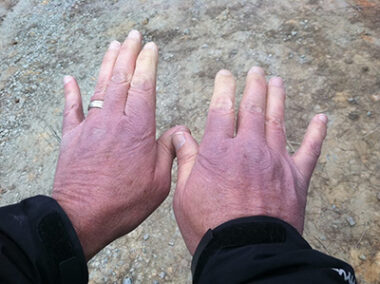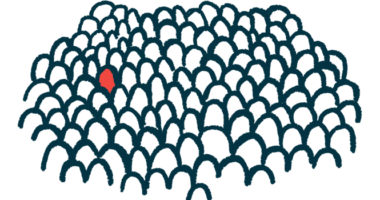Fabry disease pain can manifest in a variety of ways
Neuropathic symptoms are common, but they affect each of us in unique ways

My inspiration for writing about Fabry disease pain this month came from the graphic representation of pain shown below. Neuropathic pain is a common manifestation of Fabry that is studied and written about frequently, but this illustration is unique. It was shared with me by the pharmaceutical company Sanofi in my role as president of the National Fabry Disease Foundation.
This depiction of Fabry pain is a product of a recent patient advisory board meeting that Sanofi held to learn more about patients’ experiences with pain. Attendees’ thoughts were documented and transformed into this relatable visualization.

Graphical representation of Fabry disease pain. (Courtesy of Sanofi)
Understanding Fabry pain is an important ongoing area of study that began decades ago. It remains a frequent topic of discussion and research because it significantly affects many individuals’ daily activities and quality of life. Hundreds of peer-reviewed scientific articles have been published about various aspects of this symptom.
For many people, Fabry pain is just annoying and minimally disruptive. For others, it worsens to become severe and debilitating. Understandably, chronic pain can affect a person’s mood, demeanor, and personality, as well as their school, work, and social life.
Through the scientific literature available, talking with others, social media discussions, and my personal experiences, I’ve learned that manifestations of Fabry pain are complex and often difficult to treat. The type, location, severity, age of onset, triggers, treatments, and effects on quality of life vary widely among individuals. One article published in the journal Pain describes neuropathic Fabry pain as “burning, searing, squeezing, pressing, dragging, prickling, electrifying, tingling, sharp, and sore.” Other articles include additional unpleasant descriptions.
When I studied the pain graphic, which is a sort of mind map of the advisory group members’ thoughts, I compared their thoughts with my experiences and what I’ve learned from others. The graphical depiction is not all-encompassing, but I think it’s a good representation of the diversity and complexity of Fabry pain and its effects.
My personal relationship with pain
My pain changes often and I often experience various types simultaneously. Because I get many random, sharp, shooting pains all over my body, I can especially relate to the image of the voodoo doll in the center of the graphic. My version of the concept is that I feel like I have microscopic gremlins — those mischievous creatures of folklore in a super downsized form — running around my peripheral nervous system with their little bags of tools to stab, poke, pinch, cut, and sting me. Their modus operandi is to hit and run as they disrupt my comfort and peace of mind at their whim. My pain isn’t any fun, but isn’t not debilitating, like many others report.
My pain experiences primarily fall into the three categories below:
1. Frequent, random, sharp, shooting pains are delivered by the gremlins. Most of my pain is invisible to others, but these manifestations may be visible in instances of me flinching, grimacing, or clenching my teeth with the occasional quiet yelps.
2. Chronic, widespread flu-like achiness sometimes affects my desire or ability to participate in various activities. I’ve had some level of general achiness nearly every day for many years. It worsens with strenuous activity, temperature and humidity changes, and fevers. This affects my qualify of life the most because I don’t always feel like doing the things I’d like to do. Fortunately for me, Tylenol usually takes the edge off and I don’t need to use stronger medications.

Jerry’s hands during an episode of Raynaud’s.
(Courtesy of Jerry Walter)
3. The sensations of burning, tingling, pricking, and numbness in my extremities are known as acroparesthesia. This is often one of the earliest reported symptoms of Fabry. These sensations don’t affect me to the extent that they affect many others, except for when I have episodes of Raynaud’s syndrome secondary to Fabry. When this occurs, reduced circulation causes my hands to change colors. I also experience numbness and tingling, but it isn’t too painful. The stinging sensation as my fingers regain circulation hurts the most.
I’ve learned that Fabry pain is personal and the way it affects each individual is unique. Everyone’s visualization of their pain may look different, with a mix of common and distinct features. No one can fully understand another person’s pain or how it affects their life.
For that reason, we need to practice patience and understanding. Just because we can’t see someone’s pain doesn’t mean it’s not real!
I hope that continued awareness and research on Fabry-related pain leads to better understanding, more effective remedies, and ultimately, better lives.
Note: Fabry Disease News is strictly a news and information website about the disease. It does not provide medical advice, diagnosis, or treatment. This content is not intended to be a substitute for professional medical advice, diagnosis, or treatment. Always seek the advice of your physician or other qualified health provider with any questions you may have regarding a medical condition. Never disregard professional medical advice or delay in seeking it because of something you have read on this website. The opinions expressed in this column are not those of Fabry Disease News or its parent company, Bionews, and are intended to spark discussion about issues pertaining to Fabry disease.








Lucie Long
I started off with neuropathy in my hands, and feet 30 years ago. Heart electrical issues, anklosyin spondylitis now and si joint issues that keep my left side numb and in severe pain.
Autumn Hansen
Thank you for the description of your pain! I have been feeling this for years and was diagnosed with fibromyalgia. I don't believe that is the correct diagnosis and I'm going to be asking my doctor to order genetic testing for Fabry. My mother and grandmother both died early both had heart and kidney problems, GI issues and pain similar as to what you described. My mother died of a heart attack and my grandmother died of a stroke. I have had multiple TIAs, have breathing difficulties, Raynaud's, swelling, pain, GI issues, and so on. I have typed in "voodoo doll pain" in my browser before and have never come up with an accurate description of what I feel until you shared your pain. It's because of your article, that I was drawn to a very possible diagnosis. Though the prognosis isn't great, at least I can be tested and find out. I am sincerely thankful!
LaReane Sullivan
Wow—-thank you. This gives me hope. I cannot tell you the number of doctors who have discounted my symptoms and concerns. After crying uncontrollably after the last one, I will raise my head in triumphant……for a diagnosis.
LaReane
Dusty Daniels
Hello Luvs, I'm concerned I may have fabry disease. I was diagnosed with Graves disease which is autoimmune disease back in October 2010. Fast forward july 2024. Been going to my doctors for lump in my under arm. She sent me to physical therapy for a month! Told me insurance would pay for me to get more test like an mri. She said I needed to complete physical therapy. So I did in hopes of finding out solution to my lump in armpit and pain going down into my ribs.. fastforward physical therapy completed and letter from insurance saying they won't cover mri testing for just shoulder pain... They sent a letter to my doctor as well. I'm frustrated my doctor didn't go into more detail as far as my lump under my arm. So insurance didn't see it was necessary. Which I understand given the fact she toldcthem I had shoulder pain. Sk I don't knw how to ok get my symptoms checked out if she doesn't list real reason for mri being a lump under my arm and pain everyday. Done physical therapy that made it hurt worse w nothing for my pain and no next step. Just letter from insurance compan. I so frustrated its november.... I just want to figure out whg I'm in pain every day in my armpit. Why it feels like it's affecting my kidney too at least my right one same side my lump is my armpit.do I need to ask for genetic testing for fairy disease? I also suffer seizures, ptsd and have numbness in my hands feet too.. figured it was bc my graves disease. Muscle cramps all the time. Please give me honest advice how to check properly by my doctor how should I approach my concerns? Without being disrespectful and rude to her like I want to do outta anger but not allowing. Myself too! I actually want hideout what's wrong so